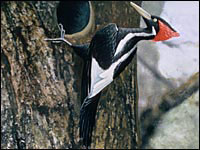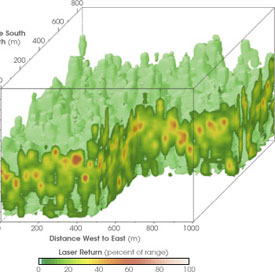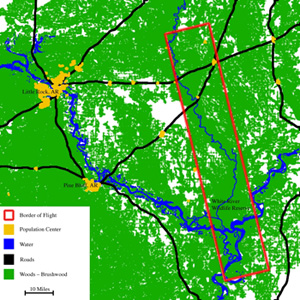NASA Assists Search for Woodpecker Thought to
be Extinct
August 02, 2006
http://www.nasa.gov/centers/goddard/news/topstory/2006/woodpecker.html
Unlike its more famous cartoon cousin Woody the Woodpecker, the
ivory-billed woodpecker is thought to be extinct, or so most
experts have believed for over half a century.
 Image to right: An artist's
image of what an ivory-billed woodpecker looks like. Credit:
George M. Sutton/Cornell Lab of Ornithology
Image to right: An artist's
image of what an ivory-billed woodpecker looks like. Credit:
George M. Sutton/Cornell Lab of Ornithology
But last month scientists from NASA and the University of
Maryland, College Park, Md., launched a project to identify
possible areas where the woodpecker might be living. Finding these
habitat areas will guide future searches for the bird and help
determine if it is really extinct or has survived an elusive
existence.
The question of whether the species still exists started when a
kayaker reported spotting the woodpecker along Arkansas' Cache
River in 2004. That sighting spawned an intensive search for the
species by wildlife conservationists, bird watchers, field
biologists and others.
In June a research aircraft flew over delta regions of the lower
Mississippi River to track possible areas of habitat suitable for
the ivory-billed woodpecker, one of the largest and most regal
members of the woodpecker family. The project is supported by the
U.S. Fish and Wildlife Service and the U.S. Geological Survey.
 Image to left: An image
produced from the airborne LVIS instrument shows a
three-dimensional view of tree tops and vegetation in the tropical
forest of La Selva, Costa Rica. The color indicates the amount of
laser energy reflected from trees and leaves back to a sensor
onboard the aircraft. Credit: John Weishampel, University of
Central Florida.
Image to left: An image
produced from the airborne LVIS instrument shows a
three-dimensional view of tree tops and vegetation in the tropical
forest of La Selva, Costa Rica. The color indicates the amount of
laser energy reflected from trees and leaves back to a sensor
onboard the aircraft. Credit: John Weishampel, University of
Central Florida.
Scientists from NASA’s Goddard Space Flight Center, Greenbelt,
Md., and the University of Maryland used NASA’s Laser Vegetation
Imaging Sensor (LVIS) onboard the aircraft. The instrument uses
lasers that send pulses of energy to the Earth's surface. Photons
of light from the lasers bounce off leaves, branches and the
ground and reflect back to the instrument. By analyzing these
returned signals, scientists receive a direct measurement of the
height of the forest's leaf covered tree tops, the ground level
below and everything in between.
"LVIS is aiding this search effort far beyond what aircraft
photos or satellite images can provide in the way of just a
two-dimensional rendering of what's below," said Woody
Turner, Program Scientist at NASA Headquarters, Washington, D.C.
"The laser technology gives us the third dimension, enabling
us to better assess the complex vegetation structure the plane
flies over." The flights are the latest step in an effort
spanning over two years to find absolute evidence that a bird once
thought extinct continues to survive.
"We're trying to understand the environment where these birds
live or used to live, using LVIS-plotted features like thickness
of the ground vegetation and tree-leaf density, in combination
with other factors like closeness to water and age of the forest,
to determine where we might find them," said Turner.
"Through numerous studies, we have shown the effectiveness of
the data generated by this sensor for many scientific uses,
including carbon removal, fire prediction, and habitat
identification,” said LVIS project researcher Ralph Dubayah, a
professor in the University of Maryland's Department of Geography.
“Lidar technology like LVIS measures the vertical structure of
the trees and ground, setting it apart from other remote-sensing
systems that provide detailed horizontal information that tells us
little about whether a green patch of forest is short or tall, for
example. When identifying habitats, the vertical structure of the
vegetation is of paramount importance to many species, including a
bird like the ivory-bill.”
 Image to right: The red border shows the forested area in
the White River Wildlife Reserve of Arkansas where researchers
flew in June and July, 2006 to identify a possible habitat for the
ivory-billed woodpecker. Click image to enlarge. Credit:
NASA
Image to right: The red border shows the forested area in
the White River Wildlife Reserve of Arkansas where researchers
flew in June and July, 2006 to identify a possible habitat for the
ivory-billed woodpecker. Click image to enlarge. Credit:
NASA
The reported sighting of the ivory-billed woodpecker inspired a
year-long search by more than 50 experts working together as part
of the Big Woods Conservation Partnership, led by the Cornell
University’s Cornell Laboratory of Ornithology and the Nature
Conservancy. Researchers have followed reported sightings across a
huge swath of the southeastern United States, including the Gulf
Coast, Alabama, and Florida.
In April 2005, that team published a report in the journal Science
that at least one male ivory-bill still survived. However, some
scientists have challenged whether it really was the ivory-billed
woodpecker that was spotted. The NASA-University of Maryland
project is designed to provide detailed habitat information that
search teams will use beginning this fall for expanded efforts to
find new evidence about the possible survival of the bird.
The project also has a broader application, according to NASA
Goddard’s Bryan Blair, principal investigator for the project.
“This field campaign is part of an effort to develop approaches
that bring together many types of remote-sensing data for
monitoring wildlife habitat.”
The research team previously used NASA's LVIS to study wildlife
habitats in old-growth forests in the western United States and
rain forests abroad.
Related Links:
Observatory Conservation Study
|